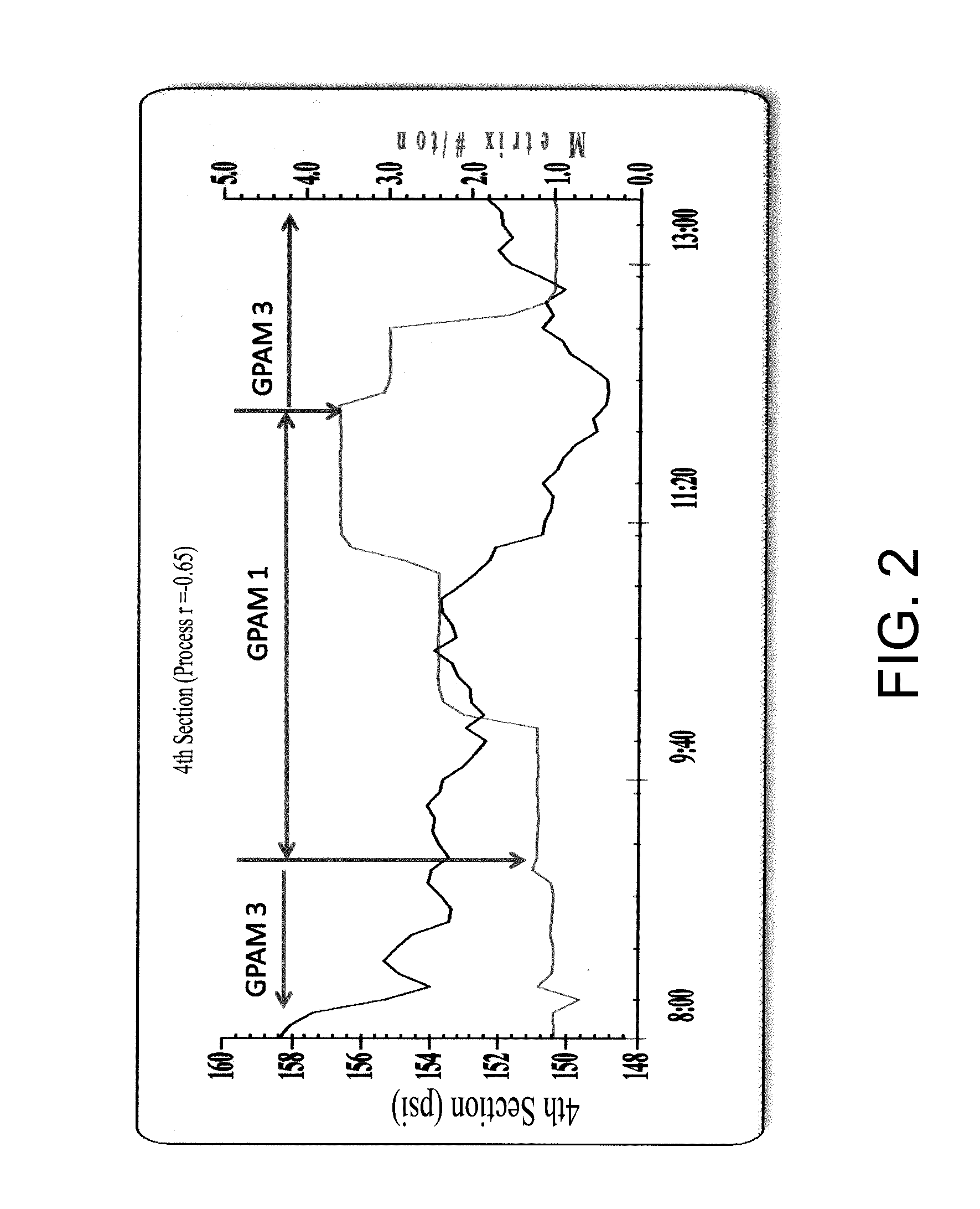Aldehyde-Functionalized Polymers for Paper Strength and Dewatering
a technology of functionalized polymers and aldehyde, which is applied in the field of compositions comprising aldehydefunctionalized polymers, can solve the problems of inefficient paper production, slow production time, and difficult manipulation of high molecular weight polymers, and achieves the effects of enhancing strength and press section dewatering, increasing shelf life, and increasing shelf li
- Summary
- Abstract
- Description
- Claims
- Application Information
AI Technical Summary
Benefits of technology
Problems solved by technology
Method used
Image
Examples
example 1
[0088]This example illustrates the glyoxalation reaction of an acrylamide / DADMAC copolymer with glyoxal to form GPAM 1.
[0089]Synthesis of GPAM 1. To a 2,000-mL reaction flask fitted with a mechanical stirrer, thermocouple, condenser, addition port and sampling valve at the bottom of the reactor was added 307.62 g of a 41% aqueous solution of 95 / 5 mole % acrylamide / DADMAC copolymer and 1470.42 g of deionized or soft water. The polymer solution was stirred at 400 rpm. The pH of the solution was adjusted to 8.8 to 9.1 by adding 6.6 g of 50% aqueous sodium hydroxide solution. The reaction temperature was set at 24 to 26° C. Glyoxal (184.72 g of a 40% aqueous solution) was added to the reaction mixture over 20 to 30 minutes. The Brookfield viscosity (Brookfield Programmable LVDV-II+ Viscometer, LV #1 spindle at 60 rpm, Brookfield Engineering Laboratories, Inc, Middleboro, Mass.) of the reaction mixture was about 4 to 5 cps after glyoxal addition. The pH of the reaction mixture was adjust...
example 2
[0091]This example provides characterization data for a glyoxalated polyamide in accordance with the present invention (GPAM 1) and glyoxalated polyamides of greater molecular weight (GPAMs 2-4). GPAM 2 is the corresponding glyoxalated polyamide of GPAM 1, but having greater molecular weight. Both GPAMs 1 and 2 were prepared by Applicants. GPAMs 3 and 4 were commercially procured.
TABLE 1unreactedmonodiunreactedmonodiBFV,Mw,sampleglyoxal, %glyoxal, %glyoxal, %amide, %amide, %amide, %cpskDGPAM 18018283143 6.3 68GPAM 2722367417818.61500GPAM 37720380155—300-1000GPAM 46725784106——
example 3
[0092]This example illustrates the STFI strength of paper produced in a laboratory using an aldehyde-functionalized polymer in accordance with an embodiment of the invention.
[0093]The STFI strength of paper produced using GPAM 1 and GPAM 2 of Example 2 was determined in accordance with TAPPI Method T826. FIG. 1 illustrates the STFI ratio of the paper per dosage of an inventive low molecular weight acrylamide / DADMAC copolymer (GPAM 1) and a high molecular weight acrylamide / DADMAC copolymer (GPAM 2) in a laboratory experiment.
[0094]The graph demonstrates that the STFI strength of lab-made paper with GPAM 1 is slightly lower than the STFI strength of lab-made paper with GPAM 2.
PUM
| Property | Measurement | Unit |
|---|---|---|
| temperature | aaaaa | aaaaa |
| mole ratio | aaaaa | aaaaa |
| mole percent | aaaaa | aaaaa |
Abstract
Description
Claims
Application Information
 Login to View More
Login to View More - R&D
- Intellectual Property
- Life Sciences
- Materials
- Tech Scout
- Unparalleled Data Quality
- Higher Quality Content
- 60% Fewer Hallucinations
Browse by: Latest US Patents, China's latest patents, Technical Efficacy Thesaurus, Application Domain, Technology Topic, Popular Technical Reports.
© 2025 PatSnap. All rights reserved.Legal|Privacy policy|Modern Slavery Act Transparency Statement|Sitemap|About US| Contact US: help@patsnap.com



